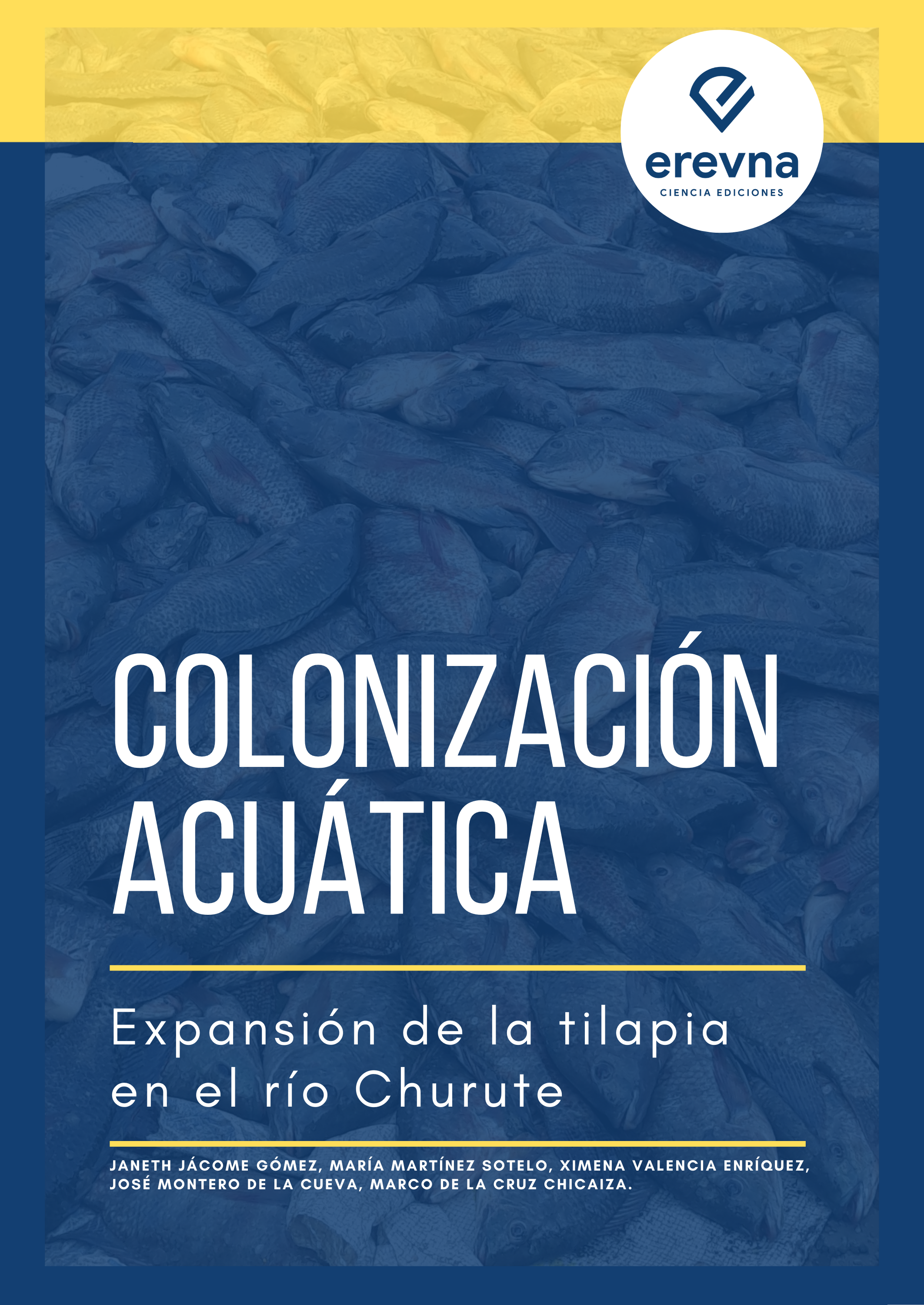Colonización Acuática: Expansión de la tilapia en el río Churute
Palabras clave:
especias introducidas, especies invasoras, ictiofauna, invasión biológica, tilapia, Oreochromis spp., peces nativos, peces exóticos, río ChuruteSinopsis
En Ecuador, el río Churute, presentaba presencia confirmada de tilapia, aunque sin estudios previos que cuantifiquen su impacto en la fauna íctica local. Por ello, el presente estudio tuvo como objetivo describir la composición de la ictiofauna en el río Churute, analizar la distribución y abundancia de tilapia, y evaluar su impacto sobre las especies nativas. Para ello, se desarrolló un estudio descriptivo en 25 sitios distribuidos a lo largo de un tramo de 17 km del río. La captura de peces se realizó mediante atarrayas. En cada sitio se registraron datos de abundancia, biomasa, longitud total y peso de los ejemplares. La identificación taxonómica se efectuó con claves especializadas, y para el análisis se calcularon índices ecológicos de riqueza, diversidad y el Índice de Importancia Relativa (IRI). En total, se capturaron 1.065 ejemplares de 20 especies de peces, distribuidas en 6 órdenes y 13 familias. De estas especies, 70% eran nativas, 25% endémicas y 5% introducidas. La especie introducida correspondió a Oreochromis spp. (tilapia) y entre las especies endémicas destacaron Leporinus ecuadorensis, Ichthyoelephas humeralis, Saccodon terminalis y Andinoacara blombergi. El IRI mostró que Oreochromis spp. fue la especie dominante (IRI = 4.0075,58), con una abundancia relativa del 61,13%, biomasa del 38,55% y frecuencia de aparición del 17,01%, y reproducción activa confirmada. Especies endémicas como Leporinus ecuadorensis, Ichthyoelephas humeralis y Brycon dentex presentaron distribuciones más limitadas. Este estudio cuantifica la dominancia y expansión de la tilapia en el río Churute, estableciendo su impacto en la composición y diversidad de la ictiofauna nativa. Los resultados constituyen una base para futuros trabajos de manejo y control de especies exóticas en ecosistemas protegidos, y para la conservación de la biodiversidad acuática en áreas vulnerables.
Descargas
Referencias
Abd El-Hack, M. E., El-Saadony, M. T., Nader, M. M., Salem, H. M., El-Tahan, A. M., Soliman, S. M., & Khafaga, A. F. (2022). Effect of environmental factors on growth performance of Nile tilapia (Oreochromis niloticus). International journal of biometeorology, 66(11), 2183-2194. https://doi.org/10.1007/s00484-022-02347-6
Abd Hamid, M., Sah, A. S. R. M., Idris, I., Nor, S. A. M., & Mansor, M. (2023). Impacts of tilapia aquaculture on native fish diversity at an ecologically important reservoir. PeerJ, 11, e15986. https://doi.org/10.7717/peerj.15986
Aguirre, W. E., Alvarez‐Mieles, G., Anaguano‐Yancha, F., Burgos Morán, R., Cucalón, R. V., Escobar‐Camacho, D., ... & Zárate Hugo, E. (2021). Conservation threats and future prospects for the freshwater fishes of Ecuador: A hotspot of Neotropical fish diversity. Journal of Fish Biology, 99(4), 1158-1189. https://doi.org/10.1111/jfb.14844
Akram, H., Hussain, S., Mazumdar, P., Chua, K. O., Butt, T. E., & Harikrishna, J. A. (2023). Mangrove health: A review of functions, threats, and challenges associated with mangrove management practices. Forests, 14(9), 1698. https://doi.org/10.3390/f14091698
Albert, J. S., Petry, P., & Reis, R. E. (2011). Major biogeographic and phylogenetic patterns. Historical biogeography of Neotropical freshwater fishes, 1, 3-20. https://doi.org/10.1525/california/9780520268685.001.0001
Albert, J. S., Tagliacollo, V. A., & Dagosta, F. (2020). Diversification of Neotropical freshwater fishes. Annual Review of Ecology, Evolution, and Systematics, 51(1), 27-53. https://doi.org/10.1146/annurev-ecolsys-011620-031032
Alexiades, A. V., & Encalada, A. C. (2017). Distribution and habitat suitability of andean climbing catfish in the Napo River basin, Ecuador. Tropical Conservation Science, 10, 1940082917709598. https://doi.org/10.1177/1940082917709598
Almeida, D. B., da Costa, M. A. P., Bassini, L. N., Calabuig, C. I. P., Moreira, C. G. A., Rodrigues, M. D. N., ... & Moreira, H. L. M. (2013). Reproductive performance in female strains of Nile tilapia, Oreochromis niloticus. Aquaculture International, 21, 1291-1300. https://doi.org/10.1007/s10499-013-9630-0
Almond, R. E., Grooten, M., & Peterson, T. (2020). Living Planet Report 2020-Bending the curve of biodiversity loss. World Wildlife Fund.
Araque Arellano, M. (Coord.), Vásconez, M., Mancheno, A., Álvarez, C., Prehn, C., Cevallos, C., & Ortiz, L. (2019). Cuencas hidrográficas. Universidad Politécnica Salesiana.
Arboleda Luzón, E. B. ., Cervantes Alava, A. R. ., Prado Carpio, E. ., & Garzón Montealegre, V. J. . . (2021). Gestión de agronegocios de la tilapia roja (Oreochromis Spp. O) y su comercialización. Revista Metropolitana De Ciencias Aplicadas, 4(2), 58-67. https://doi.org/10.62452/2283kc03
Ashouri, G., Hoseinifar, S. H., El-Haroun, E., Imperatore, R., & Paolucci, M. (2023). Tilapia fish for future sustainable aquaculture. In Novel approaches toward sustainable tilapia aquaculture (pp. 1-47). Cham: Springer International Publishing. https://doi.org/10.1007/978-3-031-38321-2_1
Azevedo-Santos, V. M., Arcifa, M. S., Brito, M. F., Agostinho, A. A., Hughes, R. M., Vitule, J. R., ... & Pelicice, F. M. (2021). Negative impacts of mining on Neotropical freshwater fishes. Neotropical Ichthyology, 19, e210001. https://doi.org/10.1590/1982-0224-2021-0001
Babiker, M., & Ibrahim, H. (1979). Studies on the biology of reproduction in the cichlid Tilapia nilotica (L.): gonadal maturation and fecundity. Journal of Fish biology, 14(5), 437-448. https://doi.org/10.1111/j.1095-8649.1979.tb03541.x
Baldisserotto, B., Urbinati, E. C., & Cyrino, J. E. P. (Eds.). (2019). Biology and physiology of freshwater neotropical fish. Academic Press. http://dx.doi.org/10.1016/C2017-0-03766-7
Barneche, D. R., & Allen, A. P. (2018). The energetics of fish growth and how it constrains food‐web trophic structure. Ecology letters, 21(6), 836-844. https://doi.org/10.1111/ele.12947
Barriga, R. (2012). Lista de peces de agua dulce e intermareales del Ecuador. Revista Politécnica, 30(3), 83–119. }
Begum, A., Mondal, S., Ferdous, Z., Zafar, M. A., & Ali, M. M. (2014). Impact of water quality parameters on monosex tilapia (Oreochromis niloticus) production under pond condition. Int J Anim Fish Sci, 2(1), 14-21.
Benavides López, C. F. (2021). Evaluación de la diversidad ictiológica del lago Yahuarcocha, provincia de Imbabura [Tesis de pregrado, Universidad Técnica del Norte]. Recuperado de https://repositorio.utn.edu.ec/handle/123456789/11753
Bernatchez, L. (2016). On the maintenance of genetic variation and adaptation to environmental change: considerations from population genomics in fishes. Journal of fish biology, 89(6), 2519-2556. https://doi.org/10.1111/jfb.13145
Bernery, C., Bellard, C., Courchamp, F., Brosse, S., Gozlan, R. E., Jarić, I., ... & Leroy, B. (2022). Freshwater fish invasions: A comprehensive review. Annual Review of Ecology, Evolution, and Systematics, 53(1), 427-456. https://doi.org/10.1146/annurev-ecolsys-032522-015551
Bezerra, L. A. V., Ribeiro, V. M., Freitas, M. O., Kaufman, L., Padial, A. A., & Vitule, J. R. S. (2019). Benthification, biotic homogenization behind the trophic downgrading in altered ecosystems. Ecosphere, 10(6), e02757.
Borrell, S. (2024, septiembre 19). Tilapia reproduction to hatching. Veterinaria Digital. https://doi.org/10.1079/9781800621640.0007
Brysiewicz, A., Czerniejewski, P., & Sieczko, L. (2023). How do different types of river maintenance works affect the ichthyofauna of small European watercourses?. Ecological Chemistry and Engineering, 30(4), 617-633.
Bueno, O. (2017). Empiricism. In The routledge handbook of scientific realism (pp. 96-107). Routledge.
Canonico, G. C., Arthington, A., McCrary, J. K., & Thieme, M. L. (2005). The effects of introduced tilapias on native biodiversity. Aquatic Conservation: Marine and Freshwater Ecosystems, 15(5), 463-483. https://doi.org/10.1002/aqc.699
Cassemiro, F. A., Bailly, D., da Graça, W. J., & Agostinho, A. A. (2018). The invasive potential of tilapias (Osteichthyes, Cichlidae) in the Americas. Hydrobiologia, 817, 133-154. https://doi.org/10.1007/s10750-017-3471-1
Celi, J. E., & Villamarín, F. (2020). Freshwater ecosystems of Mainland Ecuador: diversity, issues and perspectives. Acta Limnologica Brasiliensia, 32, e106. https://doi.org/10.1590/S2179-975X3220
Chaianunporn, T., Panthum, T., Singchat, W., Chaianunporn, K., Suksavate, W., Chaiyes, A., ... & Srikulnath, K. (2024). Sustainable Ecosystem Management Strategies for Tackling the Invasion of Blackchin Tilapia (Sarotherodon melanotheron) in Thailand: Guidelines and Considerations. Animals, 14(22), 3292. https://doi.org/10.3390/ani14223292
Champneys, T., Genner, M. J., & Ioannou, C. C. (2021). Invasive Nile tilapia dominates a threatened indigenous tilapia in competition over shelter. Hydrobiologia, 848(16), 3747-3762. https://doi.org/10.1007/s10750-020-04341-8
Chua, K. W., Tan, H. H., & Yeo, D. C. (2019). Loss of endemic fish species drives impacts on functional richness, redundancy and vulnerability in freshwater ecoregions of Sundaland. Biological Conservation, 234, 72-81. https://doi.org/10.1016/j.biocon.2019.03.019
Contreras, P. R., Murillo, M. L., Cueva, M. B. R., Bueno, J. M. A., Erazo, S. G. B., & Ramírez, J. P. C. (2021). Análisis económico financiero y de sensibilidad de la producción de tilapia (Oreochromis spp.) En la región Amazónica Ecuatoriana. Journal of Science and Research, 6(3), 205-225. https://doi.org/10.5281/zenodo.5659550
Costa Novaes, J. L., & Carvalho, E. D. (2012). Reproduction, food dynamics and exploitation level of Oreochromis niloticus (Perciformes: Cichlidae) from artisanal fisheries in Barra Bonita Reservoir, Brazil. Revista de biologia tropical, 60(2), 721-734.
Coulter, D. P., Feiner, Z. S., Coulter, A. A., & Diebel, M. W. (2022). Using individual‐based models to develop invasive species risk assessments by predicting species habitat suitability. Journal of Applied Ecology, 59(12), 3083-3097. https://doi.org/10.1111/1365-2664.14304
Craven, D., Eisenhauer, N., Pearse, W. D., Hautier, Y., Isbell, F., Roscher, C., ... & Manning, P. (2018). Multiple facets of biodiversity drive the diversity–stability relationship. Nature ecology & evolution, 2(10), 1579-1587. https://doi.org/10.1038/s41559-018-0647-7
Cunha, E. R., Winemiller, K. O., da Silva, J. C., Lopes, T. M., Gomes, L. C., Thomaz, S. M., & Agostinho, A. A. (2019). α and β diversity of fishes in relation to a gradient of habitat structural complexity supports the role of environmental filtering in community assembly. Aquatic Sciences, 81(2), 38. https://doi.org/10.1007/s00027-019-0634-3
Merino, M. A. O., Conforme, M. V. M., Véliz, J. J. J., & Conforme, M. C. M. (2018). Factores ecológicos y su incidencia en los ecosistemas del chame (dormitator latifrons) en la Segua de Canuto cantón Chone-Ecuador. Ciencia digital, 2(2), 255-276. https://doi.org/10.33262/cienciadigital.v2i2.92
de Alba, G., Mourad, N. M. N., Paredes, J. F., Sánchez-Vázquez, F. J., & López-Olmeda, J. F. (2019). Daily rhythms in the reproductive axis of Nile tilapia (Oreochromis niloticus): Plasma steroids and gene expression in brain, pituitary, gonad and egg. Aquaculture, 507, 313-321. https://doi.org/10.1016/j.aquaculture.2019.04.047
de Alba, G., Sánchez-Vázquez, F. J., & López-Olmeda, J. F. (2021). Sex Determination and Differentiation of Tilapia. In Biology and Aquaculture of Tilapia (pp. 137-156). CRC Press.
Diana, J. S., Szyper, J. P., Batterson, T. R., Boyd, C. E., & Piedrahita, R. H. (2017). Water quality in ponds. Dynamics of pond aquaculture, 53-71.
Donaldson, L. A., & Cooke, S. J. (2016). The effectiveness of non-native fish eradication techniques in freshwater ecosystems: a systematic review protocol. Environmental Evidence, 5(1), 12. https://doi.org/10.1186/s13750-016-0063-x
Fricke, R., Eschmeyer, W. N., & van der Laan, R. (eds.). 2025. Catálogo de Peces de Eschmeyer: Géneros, Especies, Referencias. Versión electrónica. http://researcharchive.calacademy.org/research/ichthyology/catalog/fishcatmain.asp
El Universo. (2012, julio 14). Operativo contra camaronera liberó tilapias y afectó un río. https://www.eluniverso.com/2012/07/14/1/1447/operativo-contra-camaronera-libero-tilapias-afecto-un-
El-Leithy, A. A., Hemeda, S. A., El Naby, W. S. A., El Nahas, A. F., Hassan, S. A., Awad, S. T., ... & Helmy, Z. A. (2019). Optimum salinity for Nile tilapia (Oreochromis niloticus) growth and mRNA transcripts of ion-regulation, inflammatory, stress-and immune-related genes. Fish physiology and biochemistry, 45, 1217-1232. https://doi.org/10.1007/s10695-019-00640-7
Elmqvist, T., Folke, C., Nyström, M., Peterson, G., Bengtsson, J., Walker, B., & Norberg, J. (2003). Response diversity, ecosystem change, and resilience. Frontiers in Ecology and the Environment, 1(9), 488-494. https://doi.org/10.1890/1540-9295(2003)001[0488:RDECAR]2.0.CO;2
El-Sayed, A. F. M. (2019). Tilapia culture. Academic press.
El‐Sayed, A. F. M., & Fitzsimmons, K. (2023). From Africa to the world—The journey of Nile tilapia. Reviews in Aquaculture, 15, 6-21. https://doi.org/10.1111/raq.12738
Erazo, B., Bourrel, L., Frappart, F., Chimborazo, O., Labat, D., Dominguez-Granda, L., ... & Mejia, R. (2018). Validation of satellite estimates (Tropical Rainfall Measuring Mission, TRMM) for rainfall variability over the Pacific slope and Coast of Ecuador. Water, 10(2), 213. https://doi.org/10.3390/w10020213
Escobar Camacho, D., Barragán, K. S., Guayasamin, J. M., Gavilanes, G., & Encalada, A. C. (2024). New records of native and introduced fish species in a river basin of Western Ecuador, the Chocó-Darien Ecoregion, using DNA barcoding. Plos one, 19(3), e0298970. https://doi.org/10.1371/journal.pone.0298970
FAO. 2009. Oreochromis niloticus. In Cultured aquatic species fact sheets. Text by Rakocy, J. E. Edited and compiled by Valerio Crespi and Michael New. CD-ROM (multilingual).
Fitzsimmons, K. (2024). Prospect and potential for global production. In Tilapia (pp. 51-72). CRC Press.
Food and Agriculture Organization of the United Nations (FAO). (2018). Tilapia Lake Virus Expert Knowledge Elicitation (EKE) Risk Assessment [Animal Health Risk Analysis Assessment No. 7]. FAO.
Food and Agriculture Organization of the United Nations (FAO). (s. f.). National Aquaculture Sector Overview – Ecuador. Recuperado de FAO sitio web: FAO
Forneck, SC, Dutra, FM, de Camargo, MP, Vitule, JRS y Cunico, AM (2021). Las instalaciones acuícolas impulsan la introducción y el establecimiento de poblaciones no nativas de Oreochromis niloticus en arroyos neotropicales. Hydrobiologia , 848 (9), 1955-1966. https://doi.org/10.1007/s10750-020-04430-8
Gonzalez-Martinez, A., De-Pablos-Heredero, C., González, M., Rodriguez, J., Barba, C., & García, A. (2021). Usefulness of discriminant analysis in the morphometric differentiation of six native freshwater species from Ecuador. Animals, 11(1), 111. https://doi.org/10.3390/ani11010111
Grizzetti, B., & Poikane, S. (2024). The Importance of Inland Waters. In Wetzel's Limnology (pp. 7-13). Academic Press. https://doi.org/10.1016/B978-0-12-822701-5.00002-1
Guerrero Alvarado, L. P. (2025). Caracterización de contaminación por microplásticos en peces según su ecología en la Reserva de Producción de Fauna Manglares El Salado (Proyecto integrador VIDA-382, Facultad de Ciencias de la Vida). Escuela Superior Politécnica del Litoral (ESPOL).
Haley, A. L., Lemieux, T. A., Piczak, M. L., Karau, S., D’Addario, A., Irvine, R. L., ... & Cooke, S. J. (2023). On the effectiveness of public awareness campaigns for the management of invasive species. Environmental Conservation, 50(4), 202-211. https://doi.org/10.1017/S037689292300019X
Halpern, B. S., & Floeter, S. R. (2008). Functional diversity responses to changing species richness in reef fish communities. Marine Ecology Progress Series, 364, 147-156. https://doi.org/10.3354/meps07553
Hernández-Delgado, E. A. (2024). Coastal restoration challenges and strategies for small island developing states in the face of sea level rise and climate change. Coasts, 4(2), 235-286. https://doi.org/10.3390/coasts4020014
Hong, P., Schmid, B., De Laender, F., Eisenhauer, N., Zhang, X., Chen, H., ... & Wang, S. (2022). Biodiversity promotes ecosystem functioning despite environmental change. Ecology letters, 25(2), 555-569. https://doi.org/10.1111/ele.13936
Instituto del Agua. (2023). Mapa Hidrológico del Ecuador: Guía completa de la hidrología del país andino. institutodelagua.es/hidrologia/mapa-hidrologico-del-ecuadorhidrologia/
Irfan, S., & Alatawi, A. M. M. (2019). Aquatic ecosystem and biodiversity: a review. Open Journal of Ecology, 9(1), 1-13. https://doi.org/10.4236/oje.2019.91001
Jácome, J., Quezada Abad, C., Sánchez Romero, O., Pérez, J. E., & Nirchio, M. (2019). Tilapia en Ecuador: paradoja entre la producción acuícola y la protección de la biodiversidad ecuatoriana. Revista peruana de biología, 26(4), 543-550. http://dx.doi.org/10.15381/rpb.v26i4.16343
Jácome-Gómez, J., Parra, R., Andrade de Pasquier, G., Jácome-Gómez, L., De la Cruz-Chicaiza, M., Zambrano-Mendoza, M., ... & Macay-Anchundia, M. (2023). Diversidad, abundancia y dominancia de las especies ícticas en el río Churute, Ecuador. Revista Cientifica de la Facultade de Veterinaria, 33(1). http://dx.doi.org/10.52973/rcfcv-e33228
Jimenez-Prado, P., & Arguello, P. (2016). Pseudochalceus lineatus. The IUCN Red List of Threatened Species 2016: e. T66598039A66639417. https://dx.doi.org/10.2305/IUCN.UK.2016-1.RLTS.T46862A66234973.en
Jiménez-Prado, P., & Vásquez, F. (2021). Cambios en diversidad y distribución de peces nativos por la presencia de dos especies invasoras en el río Atacames, noroccidente del Ecuador. Acta Biológica Colombiana, 26(1), 81-88. https://doi.org/10.15446/abc.v26n1.81888
Jiménez-Prado, P., W. Aguirre, E. Laaz-Moncayo, R. Navarrete-Amaya, F. Nugra-Salazar, E. Rebolledo-Monsalve, E. Zárate-Hugo, A. Torres-Noboa y J. Valdiviezo-Rivera. (2015). Guía de peces para aguas continentales en la vertiente occidental del Ecuador. Pontificia Universidad Católica del Ecuador Sede Esmeraldas (PUCESE); Universidad del Azuay (UDA) y Museo Ecuatoriano de Ciencias Naturales (MECN) del Instituto Nacional de Biodiversidad. Esmeraldas, Ecuador.
Jones, P. E., Tummers, J. S., Galib, S. M., Woodford, D. J., Hume, J. B., Silva, L. G., ... & Lucas, M. C. (2021). The use of barriers to limit the spread of aquatic invasive animal species: A global review. Frontiers in Ecology and Evolution, 9, 611631. https://doi.org/10.3389/fevo.2021.611631
Ju, R. T., Li, X., Jiang, J. J., Wu, J., Liu, J., Strong, D. R., & Li, B. (2020). Emerging risks of non‐native species escapes from aquaculture: call for policy improvements in China and other developing countries. Journal of Applied Ecology, 57(1), 85-90. https://doi.org/10.1111/1365-2664.13521
Kwikiriza, G., Muthoka, M., Omara, T., Abaho, I., Tibihika, P. D., Curto, M., ... & Meimberg, H. (2025). Nile Tilapia (Oreochromis niloticus L.) Cage Aquaculture in Africa: Potential Threats to Congeneric Fish Species and Advances to Detect Escapes. Aquaculture, Fish and Fisheries, 5(4), e70090. https://doi.org/10.1002/aff2.70090
Li, M., Sun, L., Zhou, L., & Wang, D. (2024). Tilapia, a good model for studying reproductive endocrinology. General and Comparative Endocrinology, 345, 114395. https://doi.org/10.1016/j.ygcen.2023.114395
López, C., Steinitz‐Kannan, M., Domínguez‐Granda, L., Soto, L. M., Gomes‐Barbosa, L., Karpowicz, M., ... & Marrone, F. (2021). Loss of a freshwater copepod species from El Junco Lake, Galápagos following the introduction and eradication of the Nile tilapia. Aquatic Conservation: Marine and Freshwater Ecosystems, 31(12), 3651-3656. https://doi.org/10.1002/aqc.3718
López-López, E., & Sedeño-Díaz, J. E. (2015). Biological indicators of water quality: The role of fish and macroinvertebrates as indicators of water quality. Environmental indicators, 643-661. https://doi.org/10.1007/978-94-017-9499-2_37
Lucifora, L. O., Scarabotti, P. A., & Barbini, S. A. (2022). Predicting and contextualizing sensitivity to overfishing in Neotropical freshwater stingrays (Chondrichthyes: Potamotrygonidae). Reviews in Fish Biology and Fisheries, 32(2), 669-686. https://doi.org/10.1007/s11160-021-09696-2
Manoel, P. S., & Uieda, V. S. (2018). Effect of the riparian vegetation removal on the trophic network of Neotropical stream fish assemblage. Revista Ambiente & Água, 13(1), e2088. https://doi.org/10.4136/ambi-agua.2088
Matovelle, C., & Heras, D. (2020). Análisis comparativo de las características morfométricas de sistemas hidrográficos de la vertiente del Pacífico, Ecuador. Investigación y Ciencia, 28(80), 22-31.
Mekonnen, E., Berihanu, G., & Yitayew, T. (2018). Length-weight relationships, sex ratios and size at first maturity of fishes of Lake Ardibo, South Wollo, Ethiopia. Abyssinia Journal of Science and Technology, 3(1), 13-19.
Mercado-Silva, N., Ornelas-García, C. P., Gidmark, N. J., Simons, A. M., Schmitter-Soto, J. J., & Burr, B. M. (2020). Characidae: Characins. Diversity of North American freshwater fishes: Natural History, Ecology & Conservation, 1-22.
Mikkola, H. (2024). Aquaculture and Fisheries as a Food Source in the Amazon Region—A Review. Food & Nutrition Journal, 9(286), 1-26. https://www.doi.org/ 10.29011/2575-7091.100186
Milardi, M., Iemma, A., Waite, I. R., Gavioli, A., Soana, E., & Castaldelli, G. (2022). Natural and anthropogenic factors drive large-scale freshwater fish invasions. Scientific Reports, 12(1), 10465. https://doi.org/10.1038/s41598-022-14556-5
Mojica, P. I., Prado, P. J., & william González-Daza. (2020). Peces de la cuenca del río Mira: Pacífico colombo-ecuatoriano. Universidad Nacional de Colombia. Facultad de Ciencias.
Monroe, T. G. R., Cantanhêde, S. P. D., Sousa, N. S. M., Monroe, N. B., Piorski, N. M., & Tchaicka, L. (2023). Inventory reveals non-native species and variation in spatial-temporal dynamics of fish community in a Brazilian protected area. Brazilian Journal of Biology, 83, e274232. https://doi.org/10.1590/1519-6984.274232
Mora, R. N. R. (2017). Análisis de su introducción al Ecuador, efectos en la alimentación local y su importancia gastronómica (Tesis de pregrado, UNIVERSIDAD SAN FRANCISCO DE QUITO).
Morán, R. E. B., & Cantos, C. A. (2023). Caracterización de la piscicultura amazónica ecuatoriana, un panorama de su desarrollo y perspectivas. AquaTechnica: Revista Iberoamericana de Acuicultura, 5(3), 1. https://doi.org/10.5281/zenodo.10443502
MOYLE, P. B., & LEIDY, R. A. (2023). Freshwater Fishes: Threatened Species. The Living Planet: The State of the World's Wildlife, 177.
Muñoz, Á. G., Macías, S., & García, M. B. (2010). Informe final de caracterización hidrológica. Proyecto INAMHI MAE SCN PRAA PACC.
Nagel, B., & Partelow, S. (2022). A methodological guide for applying the social-ecological system (SES) framework: a review of quantitative approaches. Ecology and Society, 27(4), 39. https://doi.org/10.5751/ES-13493-270439
Nagelkerken, I. (2009). Ecological connectivity among tropical coastal ecosystems (Vol. 615). Dordrecht: Springer. https://doi.org/10.1007/978-90-481-2406-0_10
Navarrete Amaya, R., Shervette, V. R., Vélez, D., & Aguirre, W. E. (2021). Patrones biogeográficos y taxonómicos de los peces de la vertiente occidental del Ecuador. Biodiversidad de Peces en el Ecuador. P. Jiménez-Prado and J. Valdiviezo-Rivera (eds.). Serie Especial de Ictiologıa Ecuatoriana I. Red Ecuatoriana de Ictiologıa, Pontificia Universidad Católica del Ecuador Sede Esmeraldas, Universidad Tecnológica Indoamérica, 22-55.
O’Mara, K., Venarsky, M., Marshall, J., & Stewart-Koster, B. (2024). Diet-habitat ecology of invasive tilapia and native fish in a tropical river catchment following a tilapia invasion. Biological Invasions, 26(2), 489-504. https://doi.org/10.1007/s10530-023-03185-2
Oswalt, S., Oswalt, C., Crall, A., Rabaglia, R., Schwartz, M. K., & Kerns, B. K. (2021). Inventory and monitoring of invasive species. Invasive species in forests and rangelands of the United States, 231. https://doi.org/10.1007/978-3-030-45367-1_10
Parfenyuk, I. O., Grokhovskaya, Y. R., & Mandygra, Y. M. (2019). Analysis of water quality of a reservoir on a small river and the status of ichthyofauna in anthropogenic conditions. Ukrainian journal of veterinary and agricultural sciences, 2(3), 28-31. https://doi.org/10.32718/ujvas2-3.07
Pelicice, F. M., Agostinho, A. A., Azevedo-Santos, V. M., Bessa, E., Casatti, L., Garrone-Neto, D., ... & Zuanon, J. (2023). Ecosystem services generated by Neotropical freshwater fishes. Hydrobiologia, 850(12), 2903-2926. https://doi.org/10.1007/s10750-022-04986-7
Perrin, S. W., Bærum, K. M., Helland, I. P., & Finstad, A. G. (2021). Forecasting the future establishment of invasive alien freshwater fish species. Journal of Applied Ecology, 58(11), 2404-2414. https://doi.org/10.1111/1365-2664.13993
Pinna, M., Zangaro, F., Saccomanno, B., Scalone, C., Bozzeda, F., Fanini, L., & Specchia, V. (2023). An overview of ecological indicators of fish to evaluate the anthropogenic pressures in aquatic ecosystems: from traditional to innovative DNA-based approaches. Water, 15(5), 949. https://doi.org/10.3390/w15050949
Prabu, E., Rajagopalsamy, C. B. T., Ahilan, B., Jeevagan, I. J. M. A., & Renuhadevi, M. J. A. R. (2019). Tilapia–an excellent candidate species for world aquaculture: a review. Annual Research & Review in Biology, 31(3), 1-14. https://doi.org/10.9734/ARRB/2019/v31i330052
Prado, P. J. J., Vásquez, F., Rodríguez-Olarte, D., & Taphorn, D. (2020). Efectos de la especie invasora (Cyprinodontiformes: Poeciliidae) sobre Pseudopoecilia fria en ríos costeros de la región del Chocó, Ecuador. Revista de Biología Tropical, 68(1), 122-138. https://doi.org/10.15517/rbt.v68i1.36000
Rao, W., Ning, J., Zhong, P., Jeppesen, E., & Liu, Z. (2015). Size-dependent feeding of omnivorous Nile tilapia in a macrophyte-dominated lake: implications for lake management. Hydrobiologia, 749, 125-134. https://doi.org/10.1007/s10750-014-2155-3
Rasoamihaingo, L. A., Razafindrajao, F., Andriambelo, H., de Roland, L. A. R., & Bamford, A. J. (2023). Effects of turbidity and introduced tilapia (Oreochromis spp) on macrophytes and invertebrates in a shallow tropical lake. Knowledge & Management of Aquatic Ecosystems, (424), 2. https://doi.org/10.1051/kmae/2022025
Reid, A. J., Carlson, A. K., Creed, I. F., Eliason, E. J., Gell, P. A., Johnson, P. T., ... & Cooke, S. J. (2019). Emerging threats and persistent conservation challenges for freshwater biodiversity. Biological reviews, 94(3), 849-873. https://doi.org/10.1111/brv.12480
Reis, R. E., Albert, J. S., Di Dario, F., Mincarone, M. M., Petry, P., & Rocha, L. A. (2016). Fish biodiversity and conservation in South America. Journal of fish biology, 89(1), 12-47. https://doi.org/10.1111/jfb.13016
Rice, M. A. (2021). Intensive fishing effort and market controls as management tools for invasive aquatic species: A review. Asian Fisheries Science, 34(4), 383-392. https://doi.org/10.33997/j.afs.2021.34.4.011
Rico-Sánchez, A. E., Sundermann, A., López-López, E., Torres-Olvera, M. J., Mueller, S. A., & Haubrock, P. J. (2020). Biological diversity in protected areas: Not yet known but already threatened. Global Ecology and Conservation, 22, e01006. https://doi.org/10.1016/j.gecco.2020.e01006
Ríos, N., Pardo, B. G., Fernández, C., Alvarez‐Dios, J. A., Martínez, P., Bouza, C., & García, G. (2025). Transcriptomic divergence and associated markers between genomic lineages of silver catfish (Rhamdia quelen). Ecology and Evolution, 15(3), e71021. https://doi.org/10.1002/ece3.71021
Rizzato, P. P., & Almeida, M. A. (2025). An overview of some of the main features of the external anatomy of catfishes. Catfishes, a Highly Diversified Group, 21-49.
Rodríguez-Echeverry, J., & Leiton, M. (2021). Pérdida y fragmentación de ecosistemas boscosos nativos y su influencia en la diversidad de hábitats en el hotspot Andes tropicales. Revista mexicana de biodiversidad, 92. https://doi.org/10.22201/ib.20078706e.2021.92.3449
Román-Valencia, C., Ruiz, R. I., & Barriga, R. (2005). Una nueva especie ecuatoriana del género de peces andinos Grundulus (Characiformes: Characidae). Revista de Biología Tropical, 53(3-4), 537-544.
Römer, U., & Hahn, I. (2013). Apistogramma aguarico sp. n.: A new species of geophagine cichlid fish (Teleostei: Perciformes) from the Ecuadorian and Peruvian río Napo system. Vertebrate Zoology, 63, 171-181.
Russell, D. J., Thuesen, P. A., & Small, F. E. (2012). Tilapia in Australia–Development of management strategies for the control and eradication of feral tilapia populations in Australia. Invasive Animals Cooperative Research Centre.
Rytwinski, T., Taylor, J. J., Donaldson, L. A., Britton, J. R., Browne, D. R., Gresswell, R. E., ... & Cooke, S. J. (2019). The effectiveness of non-native fish removal techniques in freshwater ecosystems: a systematic review. Environmental Reviews, 27(1), 71-94. https://doi.org/10.1139/er-2018-0049
Sánchez-Vázquez, F. J., & Fortes-Silva, R. (2021). Biology and aquaculture of tilapia (p. 20220124224). J. F. López-Olmeda (Ed.). Boca Raton, Florida: CRC Press.
Sastraprawira, S. M., Razak, I. H. A., Shahimi, S., Pati, S., Edinur, H. A., John, A. B., ... & Nelson, B. R. (2020). A review on introduced Cichla spp. and emerging concerns. Heliyon, 6(11). https://doi.org/10.1016/j.heliyon.2020.e05370
Schiemer, F. (2000). Fish as indicators for the assessment of the ecological integrity of large rivers. Hydrobiologia, 422(0), 271-278. https://doi.org/10.1023/A:1017086703551
Shechonge, A., Ngatunga, B. P., Bradbeer, S. J., Day, J. J., Freer, J. J., Ford, A. G., ... & Genner, M. J. (2019). Widespread colonisation of Tanzanian catchments by introduced Oreochromis tilapia fishes: the legacy from decades of deliberate introduction. Hydrobiologia, 832(1), 235-253. https://doi.org/10.1007/s10750-018-3597-9
Shechonge, A., Ngatunga, B. P., Tamatamah, R., Bradbeer, S. J., Harrington, J., Ford, A. G., ... & Genner, M. J. (2018). Losing cichlid fish biodiversity: genetic and morphological homogenization of tilapia following colonization by introduced species. Conservation Genetics, 19(5), 1199-1209. https://doi.org/10.1007/s10592-018-1088-1
Shuai, F., & Li, J. (2022). Nile tilapia (Oreochromis niloticus Linnaeus, 1758) invasion caused trophic structure disruptions of fish communities in the south China river—Pearl River. Biology, 11(11), 1665. https://doi.org/10.3390/biology11111665
Siva, L. A., Kimura, R. S. Y., Brambilla, E. M., Silva, S. O., & Nogueira, M. G. (2023). Impacts of an urban flood control infrastructure on the limnology and ichthyofauna of a basaltic Cuesta stream (southeast Brazil). Brazilian Journal of Biology, 83, e276585. https://doi.org/10.1590/1519-6984.276585
Stauffer Jr, J. R., Chirwa, E. R., Jere, W., Konings, A. F., Tweddle, D., & Weyl, O. (2022). Nile Tilapia, Oreochromis niloticus (Teleostei: Cichlidae): a threat to native fishes of Lake Malawi?. Biological Invasions, 24(6), 1585-1597. https://doi.org/10.1007/s10530-022-02756-z
Sunarto, A., Grimm, J., McColl, K. A., Ariel, E., Nair, K. K., Corbeil, S., ... & Holmes, B. (2022). Bioprospecting for biological control agents for invasive tilapia in Australia. Biological Control, 174, 105020. https://doi.org/10.1016/j.biocontrol.2022.105020
Suresh, A. V., & Lin, C. K. (1992). Tilapia culture in saline waters: a review. Aquaculture, 106(3-4), 201-226. https://doi.org/10.1016/0044-8486(92)90253-H
Tamario, C., Sunde, J., Petersson, E., Tibblin, P., & Forsman, A. (2019). Ecological and evolutionary consequences of environmental change and management actions for migrating fish. Frontiers in Ecology and Evolution, 7, 271. https://doi.org/10.3389/fevo.2019.00271
Tedesco, P. A., Beauchard, O., Bigorne, R., Blanchet, S., Buisson, L., Conti, L., ... & Oberdorff, T. (2017). A global database on freshwater fish species occurrence in drainage basins. Scientific data, 4(1), 1-6. https://doi.org/10.1038/sdata.2017.141
Teem, J. L., Alphey, L., Descamps, S., Edgington, M. P., Edwards, O., Gemmell, N., ... & Roberts, A. (2020). Genetic biocontrol for invasive species. Frontiers in bioengineering and biotechnology, 8, 452. https://doi.org/10.3389/fbioe.2020.00452
Thomaz, S. M., Cardozo, A. L. P., Quirino, B. A., Yofukuji, K. Y., Aleixo, M. H. F., & Fugi, R. (2025). A review of the ecological role of aquatic macrophytes on freshwater fish. Hydrobiologia, 1-34. https://doi.org/10.1007/s10750-025-05819-z
Thorstensen, M. J., Vandervelde, C. A., Bugg, W. S., Michaleski, S., Vo, L., Mackey, T. E., ... & Jeffries, K. M. (2022). Non-lethal sampling supports integrative movement research in freshwater fish. Frontiers in Genetics, 13, 795355. https://doi.org/10.3389/fgene.2022.795355
Tognelli, M. F., Anderson, E. P., Jiménez‐Segura, L. F., Chuctaya, J., Chocano, L., Maldonado‐Ocampo, J. A., ... & Villa‐Navarro, F. A. (2019). Assessing conservation priorities of endemic freshwater fishes in the Tropical Andes region. Aquatic Conservation: Marine and Freshwater Ecosystems, 29(7), 1123-1132. https://doi.org/10.1002/aqc.2971
Tonella, L. H., Ruaro, R., Daga, V. S., Garcia, D. A. Z., Vitorino, O. B., Lobato‐de Magalhães, T., ... & Carmassi, G. R. (2023). NEOTROPICAL FRESHWATER FISHES: A dataset of occurrence and abundance of freshwater fishes in the Neotropics. Ecology, 104(4), e3713. https://doi.org/10.1002/ecy.3713
Torres Ch, G. (2013). Evaluación de especies invasoras acuáticas al interior del Golfo de Guayaquil: Caso de estudio sector camaronero en el 2011. Revista Universidad De Guayaquil, 116(2), 51–62. https://doi.org/10.53591/rug.v116i2.680
Vajargah, M. F. (2021). A review of the physiology and biology of Nile tilapia (Oreochromis niloticus). J Aquac Mar Biol, 10(5), 244-246.
Valladão, G. M. R., Gallani, S. U., & Pilarski, F. (2018). South American fish for continental aquaculture. Reviews in Aquaculture, 10(2), 351-369. https://doi.org/10.1111/raq.12164
Valverde Carache, X. A. (2023). Desarrollo de actividades acuícolas dentro del área protegida Reserva Ecológica Manglares de Churute en Ecuador. Universidad Externado de Colombia, Facultad de Derecho.
van der Sleen, P., & Albert, J. S. (2022). Patterns in freshwater fish diversity. Reference Module in Earth Systems and Environmental Sciences, 26(3), 894-907.
Waldman, M., & Shevah, Y. (2000). Biological diversity—an overview. Environmental challenges, 299-310. https://doi.org/10.1023/A:1005268804246
Waldock, C., Wegscheider, B., Josi, D., Calegari, B. B., Brodersen, J., Jardim de Queiroz, L., & Seehausen, O. (2024). Deconstructing the geography of human impacts on species’ natural distribution. Nature Communications, 15(1), 8852. https://doi.org/10.1038/s41467-024-52993-0
Williams‐Subiza, E. A., & Epele, L. B. (2021). Drivers of biodiversity loss in freshwater environments: A bibliometric analysis of the recent literature. Aquatic Conservation: Marine and Freshwater Ecosystems, 31(9), 2469-2480. https://doi.org/10.1002/aqc.3627
WOAH (2022). Infection with tilapia lake virus (TiLV) – a novel orthomyxo-like virus. En WOAH Technical Disease Card. El agente se clasificó como Tilapia tilapinevirus (ICTV, 2018); descrito por primera vez por Eyngor et al. (2014).
Xiong, W., Guo, C., Gozlan, R. E., & Liu, J. (2023). Tilapia introduction in China: Economic boom in aquaculture versus ecological threats to ecosystems. Reviews in Aquaculture, 15(1), 179-197. https://doi.org/10.1111/raq.12710
Xu, M., Li, S. P., Liu, C., Tedesco, P. A., Dick, J. T., Fang, M., ... & Mu, X. (2024). Global freshwater fish invasion linked to the presence of closely related species. Nature Communications, 15(1), 1411. https://doi.org/10.1038/s41467-024-45736-8
Yearbook, F. A. O. F. A. O. (2019). Fishery and aquaculture statistics 2016. FAO: Rome, Italy.
Yongo, E., Zhang, P., Mutethya, E., Zhao, T., & Guo, Z. (2023). The invasion of tilapia in South China freshwater systems: A review. Lakes & Reservoirs: Research & Management, 28(1), e12429. https://doi.org/10.1111/lre.12429
Yousefi, M., Jouladeh‐Roudbar, A., & Kafash, A. (2024). Mapping endemic freshwater fish richness to identify high‐priority areas for conservation: An ecoregion approach. Ecology and Evolution, 14(2), e10970. https://doi.org/10.1002/ece3.10970
Zengeya, T. A., Robertson, M. P., Booth, A. J., & Chimimba, C. T. (2013). A qualitative ecological risk assessment of the invasive Nile tilapia, Oreochromis niloticus in a sub‐tropical African river system (Limpopo River, South Africa). Aquatic Conservation: Marine and Freshwater Ecosystems, 23(1), 51-64. https://doi.org/10.1002/aqc.2258
Zhang, X., Mei, X., & Gulati, R. D. (2017). Effects of omnivorous tilapia on water turbidity and primary production dynamics in shallow lakes: implications for ecosystem management. Reviews in Fish Biology and Fisheries, 27(1), 245-254. https://doi.org/10.1007/s11160-016-9458-6
Zhao, C., Shao, N., Yang, S., Ren, H., Ge, Y., Zhang, Z., ... & Yin, X. (2019). Integrated assessment of ecosystem health using multiple indicator species. Ecological Engineering, 130, 157-168. https://doi.org/10.1016/j.ecoleng.2019.02.016
Zhou, L., Wang, G., Kuang, T., Guo, D., & Li, G. (2019). Fish assemblage in the Pearl River estuary: Spatial‐seasonal variation, environmental influence and trends over the past three decades. Journal of Applied Ichthyology, 35(4), 884-895. https://doi.org/10.1111/jai.13912











